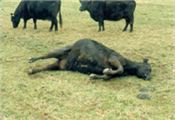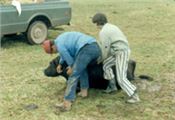Lessons From 1973 Influence Extension Specialist’s Recommendation To Feed Extra Magnesium To Cows During The Winter To Avoid Grass Tetany
MT. VERNON, MO.
For over 40 years, January has been “grass tetany month” for Eldon Cole, a livestock specialist with University of Missouri Extension. That is because, since the 1970’s, he has been reminding livestock producers this time of year to include extra magnesium in their cow’s minerals to guard against grass tetany (also known as winter tetany, grass staggers or hypomagnesemia).
“I still check with veterinarians and farmers each winter to see if any unusual amount of tetany is showing up, but it is certainly not to the degree we experienced 40 years ago,” said Cole.
A positive tetany diagnosis is hard because it can be confused with milk fever according to Cole. Sometimes it may even be confused with a lack of feed.
SYMPTOMS AND TREATMENT
The true tetany typically affects older cows, those six years and above. Those cows may either be in late gestation or early lactation. In the early stages, a producer may notice a normally calm cow being a little nervous. As time passes, she could become aggressive and staggers around.
“If not treated she’ll fall and be unable to right herself. She’ll lie on her side and thrash around with her legs in a paddling motion. Soon she likely will die with evidence showing her struggles,” said Cole.
Treatment involves giving intravenous solutions that contain calcium and magnesium. Oral drenches or enemas can be used. Affected cows should respond and be back on their feet shortly after treatment. Sometimes those cows may relapse and need to be treated again.
1973 TETANY OUTBREAK
Cole’s first serious experience with tetany was in the winter of 1973.
“I’ve gone back in my notes to see how we handled that alarming problem back then,” said Cole. “From December 15, 1972, until April 12, 1973, I logged 65 calls from farmers with tetany cows. I do not have any actual death count, but several died.”
According to Cole, most of the calls back in 1973 were from Lawrence, Barry, Greene, Christian and Stone counties. On most farms only one to four head was affected. The first cases involved cows with two to three-month-old calves on them. As we moved toward April, the tetany symptoms were in cows with two to three-week-old calves nursing them.
“I recall at that time there were differing opinions as to what caused the problem to be so bad. Some felt it was a bacterial concern, but most agreed magnesium was involved,” said Cole.
Since then significant research has found there are imbalances between magnesium, phosphorus, nitrogen and potassium in the soil and forage. Weather with cold, cloudy, damp conditions is also troublesome to the situation. Wet soils could also play a part.
“Genetics seems also to be involved. In the 70’s a University veterinarian said that we killed off all the sensitive tetany cows in 1973 so we should not have problems for several years. Blame was cast on farmers who over fertilized. The problem involved the animal, soil, forage and weather,” said Cole.
RECOMMENDATION
Cole says he still recommends feeding extra magnesium this time of year (until mid-April) as an insurance policy approach against tetany.
“If you feel your tetany risk is low, maybe just feed legume hay or early-cut grass hay. You might even have a forage test run on your hay to see if the magnesium level is 0.2 to 0.3 percent,” said Cole. “If you choose to feed mineral I suggest it contain 10 percent mag. If you mix mag into a protein/energy, feed the target should be to get 1 to 2 ounces per day of magnesium oxide into the cow.” ∆

A tetany cow down in the field
Photo credit: MU Extension

Working to get a tetany-impacted cow back on her feet.